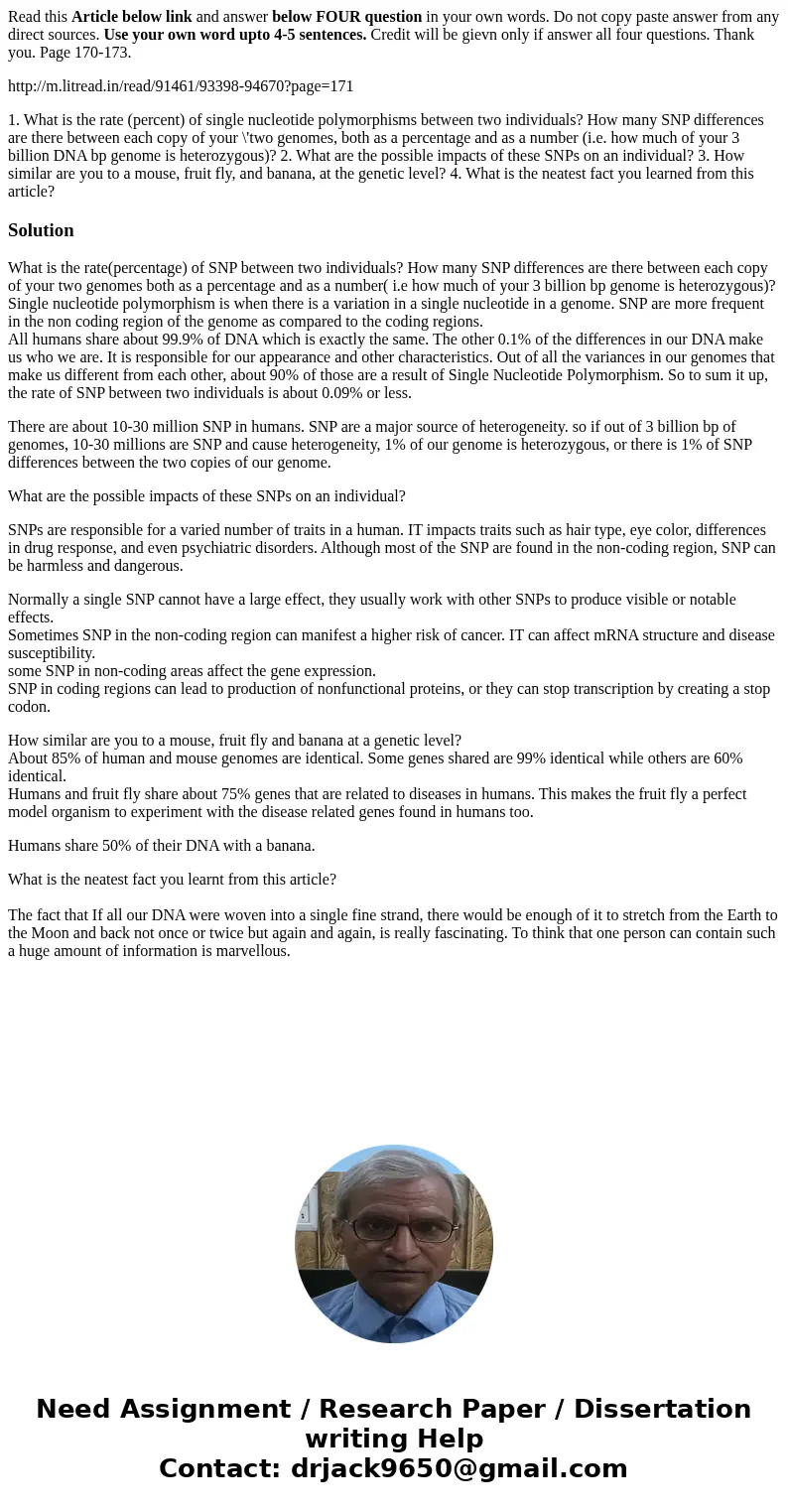Read this Article below link and answer below FOUR question
Read this Article below link and answer below FOUR question in your own words. Do not copy paste answer from any direct sources. Use your own word upto 4-5 sentences. Credit will be gievn only if answer all four questions. Thank you. Page 170-173.
http://m.litread.in/read/91461/93398-94670?page=171
1. What is the rate (percent) of single nucleotide polymorphisms between two individuals? How many SNP differences are there between each copy of your \'two genomes, both as a percentage and as a number (i.e. how much of your 3 billion DNA bp genome is heterozygous)? 2. What are the possible impacts of these SNPs on an individual? 3. How similar are you to a mouse, fruit fly, and banana, at the genetic level? 4. What is the neatest fact you learned from this article?Solution
What is the rate(percentage) of SNP between two individuals? How many SNP differences are there between each copy of your two genomes both as a percentage and as a number( i.e how much of your 3 billion bp genome is heterozygous)?
Single nucleotide polymorphism is when there is a variation in a single nucleotide in a genome. SNP are more frequent in the non coding region of the genome as compared to the coding regions.
All humans share about 99.9% of DNA which is exactly the same. The other 0.1% of the differences in our DNA make us who we are. It is responsible for our appearance and other characteristics. Out of all the variances in our genomes that make us different from each other, about 90% of those are a result of Single Nucleotide Polymorphism. So to sum it up, the rate of SNP between two individuals is about 0.09% or less.
There are about 10-30 million SNP in humans. SNP are a major source of heterogeneity. so if out of 3 billion bp of genomes, 10-30 millions are SNP and cause heterogeneity, 1% of our genome is heterozygous, or there is 1% of SNP differences between the two copies of our genome.
What are the possible impacts of these SNPs on an individual?
SNPs are responsible for a varied number of traits in a human. IT impacts traits such as hair type, eye color, differences in drug response, and even psychiatric disorders. Although most of the SNP are found in the non-coding region, SNP can be harmless and dangerous.
Normally a single SNP cannot have a large effect, they usually work with other SNPs to produce visible or notable effects.
Sometimes SNP in the non-coding region can manifest a higher risk of cancer. IT can affect mRNA structure and disease susceptibility.
some SNP in non-coding areas affect the gene expression.
SNP in coding regions can lead to production of nonfunctional proteins, or they can stop transcription by creating a stop codon.
How similar are you to a mouse, fruit fly and banana at a genetic level?
About 85% of human and mouse genomes are identical. Some genes shared are 99% identical while others are 60% identical.
Humans and fruit fly share about 75% genes that are related to diseases in humans. This makes the fruit fly a perfect model organism to experiment with the disease related genes found in humans too.
Humans share 50% of their DNA with a banana.
What is the neatest fact you learnt from this article?
The fact that If all our DNA were woven into a single fine strand, there would be enough of it to stretch from the Earth to the Moon and back not once or twice but again and again, is really fascinating. To think that one person can contain such a huge amount of information is marvellous.

 Homework Sourse
Homework Sourse